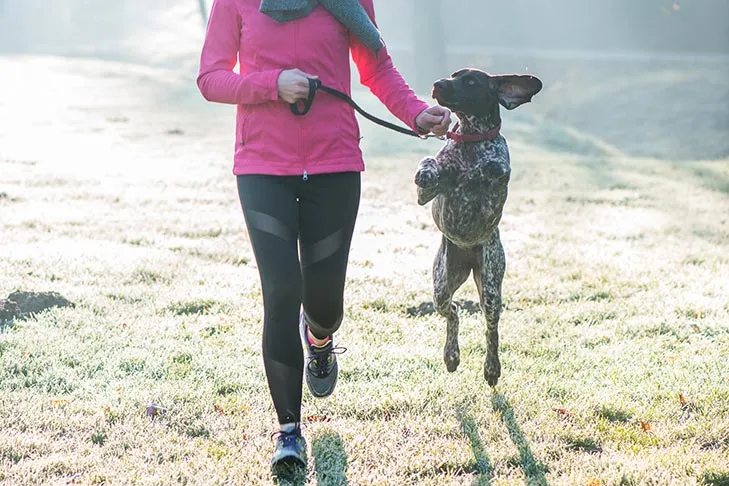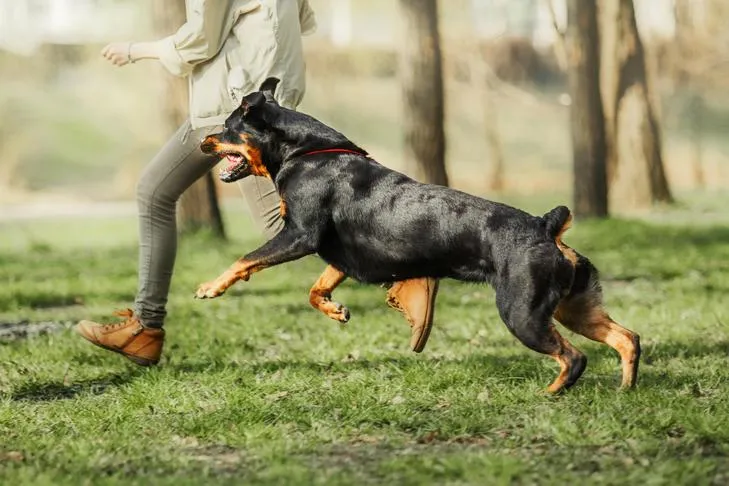Running with your canine companion is a fantastic way to bond, stay active, and ensure both of you maintain excellent physical condition. For many dog owners, having a dedicated running partner provides invaluable motivation. However, if you’re looking to train your puppy to join you on runs, there are crucial considerations and steps to follow to ensure their safety and enjoyment, especially regarding their age and physical development.
Understanding the Right Age and Breed for Running
Before embarking on a running program with your furry friend, it’s vital to assess if your dog is physically suited for such activity. Crucially, running is generally not safe for puppies. Their bones are still developing, and high-impact activities like running can lead to irreversible damage to their growth plates. For most breeds, it’s recommended to wait until your dog is approximately 1.5 years old before introducing them to regular running sessions.
Beyond age, breed characteristics play a significant role. Some breeds are naturally more inclined and built for endurance running, while others, particularly brachycephalic (short-nosed) breeds or very large breeds prone to joint issues, may not be suitable. Even within breeds, individual personalities vary; some dogs will take to running eagerly, while others prefer a more relaxed pace. Always consider your puppy’s temperament, research their breed’s running suitability, and consult with your veterinarian for a thorough physical checkup to confirm that running is a safe activity once they reach maturity.
Master Loose-Leash Walking First
A foundational step in how to train your puppy to run with you involves mastering prevent leash pulling during everyday walks. A dog that constantly pulls on the leash can be frustrating when walking, but it becomes genuinely dangerous at faster running speeds, potentially causing trips or injuries for both of you. The outdoor environment is full of exciting rewards like squirrels and novel smells. To ensure your future running partner stays by your side with a slack leash (forming a ‘J’ shape), you must be an equally rewarding presence. Utilize high-value treats, favorite toys, and enthusiastic praise to reinforce your dog whenever they maintain a loose leash.
Keeping your dog consistently on one side of you (either left or right) will be essential once you begin running together. If they dart in front or weave from side to side, they can easily trip you or tangle your legs in the leash. The chosen side doesn’t matter, but consistency does. Begin this training at a walking pace, always mindful of reward placement. If you want your puppy to stay on your left, offer treats exclusively at your left leg. Once they’ve mastered staying on one side, you can teach them to work on the other side using a different verbal cue. Many runners find a hands-free dog leash beneficial for comfort and control.
 German Shorthaired Pointer running with a woman in the early morning.
German Shorthaired Pointer running with a woman in the early morning.
Introduce Speed Cues Gradually
Once your young dog (now past their puppy stage and vet-cleared for running) is politely walking by your side, it’s time to incrementally increase the pace. During your walks, it’s helpful to have a distinct cue, such as “let’s go,” to signal that it’s time to move forward and walk. A separate, specific cue like “get running” or “move it” can then be introduced to tell your dog it’s time to pick up speed. The more clear information you can provide your dog about your expectations, the more adept they will become at responding appropriately to different commands.
To teach the running cue, incorporate short bursts of jogging or running into your regular walks. Simply give the chosen cue immediately before you accelerate, then reward your dog when they quickly adjust their pace to match yours. Similarly, you can teach a cue like “whoa” to signal a slowdown or a stop, reinforcing them when they respond promptly. This graduated approach helps your dog understand the different speeds you expect and respond reliably.
Building Your Dog’s Running Endurance
With your dog now understanding how to stay at your side and match your pace, the next step is to gradually build their physical fitness. Just as human runners need to slowly increase strength and endurance, so does your dog. Begin by adding small, manageable stretches of running into your daily walks. Over subsequent days and weeks, progressively increase the duration of time spent running and decrease the duration of walking segments. This slow, steady progression allows your dog’s body to adapt safely and effectively. After several weeks of consistent, incremental training, your dog will have developed the endurance needed for longer runs. Remember, patience is key, and never push your dog beyond their current capabilities. If you need to refine their manners, consider exploring curb dog jumping or other polite behavior training.
 Rottweiler running in the park playing with its owner.
Rottweiler running in the park playing with its owner.
Essential Tips for a Safe and Enjoyable Run
Now that your dog is trained and conditioned to be your running companion, several important tips will ensure every outing is safe and enjoyable for both of you:
- Warm-up and Cool-down: Always begin your runs with several minutes of walking to warm up your dog’s muscles and end with a cool-down walk.
- Monitor Weather Conditions: Dogs don’t regulate body temperature as efficiently as humans. Be highly aware of heat, humidity, and extreme cold, and adjust your runs accordingly.
- Hydration is Key: Always carry fresh water and offer it to your dog frequently throughout your run, even if they don’t seem thirsty.
- Provide Breaks: Allow your dog regular breaks to rest, relieve themselves, and explore their surroundings briefly.
- Off-Leash Safety: Only allow your dog to run off-leash in designated safe and legal areas, and only if they possess a highly reliable recall command, even amidst distractions. For more advanced control, explore off-leash walking skills.
- Watch for Warning Signs: Pay close attention to your dog for any signs of fatigue, overheating, or distress, such as excessive panting, lagging behind, or seeking shade. Dogs often try to please their owners, even when they’re ready to stop. If you notice them trying to stop dog jumping on you as a sign of stress, it’s time to pause.
 Beagle on leash running with a woman on a trail.
Beagle on leash running with a woman on a trail.
Maintaining Fitness in Extreme Weather
Even dedicated runners face days when the weather—be it pouring rain, heavy snow, or scorching heat—makes outdoor running unsuitable or unsafe for dogs. On such days, it’s still possible to maintain your dog’s physical conditioning with indoor exercise options. Depending on their size, a spirited game of fetch down a long hallway or up and down a carpeted staircase can effectively elevate your dog’s heart rate and work their muscles. You can also create a fun obstacle course using household items like a hula hoop or cardboard boxes, offering both physical and mental stimulation. Additionally, many dog training facilities provide indoor agility classes that allow dogs to run and jump in a controlled environment.
Some dogs can even be trained to use a treadmill. While specialized dog treadmills exist, a human treadmill can also work if the ramp length is appropriate for your dog’s size (larger dogs need longer treadmills). Although treadmills offer a convenient indoor workout, never simply place your dog on one and leave them unsupervised. Thoroughly research treadmill training techniques or consult a professional dog trainer to ensure your dog enjoys the machine and uses it safely. Most importantly, never tie your dog to the treadmill or leave them unattended during use.
Conclusion
Training your puppy to eventually run with you is a rewarding journey that builds a strong bond and keeps you both fit. Remember that patience, consistency, and a deep understanding of your dog’s physical limitations, especially during their developmental stages, are paramount. By prioritizing their safety, starting with foundational skills like loose-leash walking, and gradually building up their endurance, you can cultivate a happy and healthy running partnership. Always consult your veterinarian before starting any new exercise regimen, and enjoy the many miles you’ll share together.
